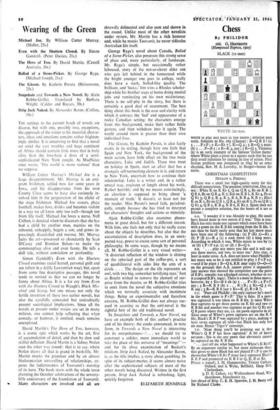Chess
By PHIL1DOR 266. G. Hurncons (Hampstead Express, I905) BLACK (ix men) a
WHITE (10 men, WHITE to play and mate in two moves; next week. Solution to No. 265 (Cheney) : 1—Q R 8 I (a) : . P x P; 2 K—Kt 7 !,K—Q 4; 3 R— mate. (b) I . • • P—B 5; 2 B--K 4, any ; 3 R—Q 3. Variation (a) is an early example of the famous 'Indian theme' where White plays a piece to a square such that he can then avoid stalemate by cutting its line of action. First Indian problem was composed in 1845 by an army chaplain, Rev. H. A. Loveday, in Bengal—hence the name.
CHRISTMAS COMPETITION MOULDY V. PHIDDLE
There was a small but high-quality entry for this difficult competition. The position (SPECTATOR, Dec.24) was : White K on K Kt 5, Q on Q R 3, Rs on K R 7, QR6,BsonQR4,K7,KtsonKI3 i,KKt4,Pson Q Kt 3, Q B 5, K 4, K 5, K 6, IC B 4, K R 5; Black K on K I,RsonQR I, Q R 4, Kt on R 7, Ps on Q R 7, Q Kt 4, Q B 5, K B 4, K B 6, K Kt 2. Space does not permit a complete solution, but the bones of it are as follows : A.A. 'I wonder if it was Mouldy to play. He could have forced mate in two moves if it was.' This is true. Black has only made one capture which must have been with a pawn on the K B file coming from the K file. It can then be fairly easily seen that his last move must have been one of the following : (a) P (Kt 2)—Kt 4 (b) P (B 2)—B 4 (c) a rook move (d) a king move. According to which it was, White mates in two by (a) or (b) z PxP e.p. (c) or (d) I B—Q 6. B.s. . . . play any move you like and it will take you three moves, not two, to mate me.' Also true, at least in some sense. A.A. does not know what Phiddle's last move was so he is not entitled to play it P x P e.p. —and if he plays 1 B--Q 6, B.B. may reply 0 0 0 on the grounds that A.A. cannot prove it impossible (any answer that showed the competitor saw the point of B.B's. remarks was adjudged correct, whether or not it accepted B.B's. logic). There is a mate in three moves, however, by I Kt—B 6 ch (a) z . P x Kt ; 2 P x any ; 3 R—K R 8 (b) . . . K x B ; 2 Kt—Q 5 ch, K any ; 3 R—K R 8 (riot i Kt—K 3?, R x R I). c.c. 'Poor old Phiddle ; the only capture he's made in the whole game is P x P.' This is false. If a pawn was captured it was taken on K B file. It takes White four captures to get three pawns on K file and two on K B file and another two captures to get his Q Kt and Q B pawn where they are, i.e. six pawn captures in all Since none of White's pawn captures are on the K R file, Black's K R P was captured by a piece, making at least seven captures all told—but Black has only lost six men. Hence 'Tiger's' contempt. T.P. 'Next thing you'll be pointing out is that White's Q R P has been captured.' A bit of heavy sarcasm ; this is the one pawn that obviously cannot be captured on the K B file. . . . just tell me what happened to White's K Kt P.' By an argument similar to, but more elaborate than, that given to show Black has not played P x P it can be shown that White's K Kt P must have captured Black's K R P and promoted on K R 8 to Q, R, B or Kt. Prizes: r (equal), J. M. Hammersley, Trinity College,
Oxford, and S. Wylie, Bellfield, Harp Hill, Cheltenham.
3, D. E. Cohen, Wythenshawe Road, WY- thershawe, Manchester 23, just ahead of Brig. C. E. H. Sparrow, J. H. Beaty and Sir Richard Clarke.


































 Previous page
Previous page